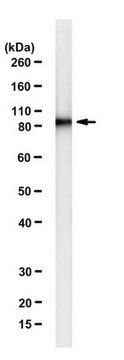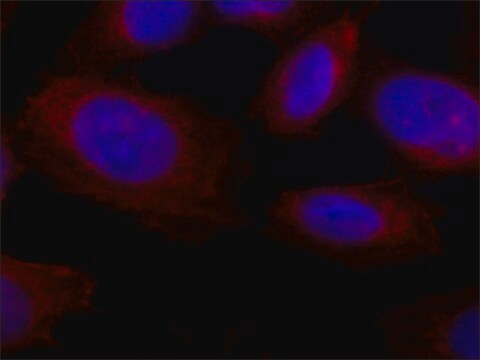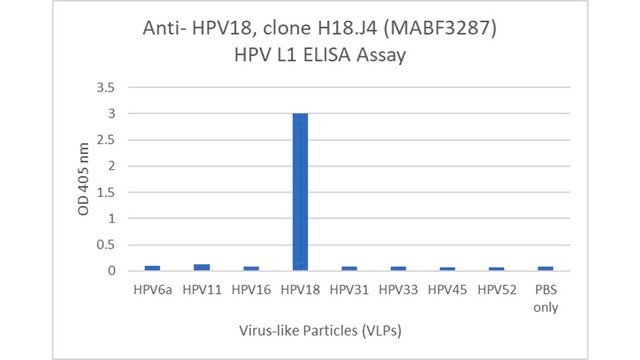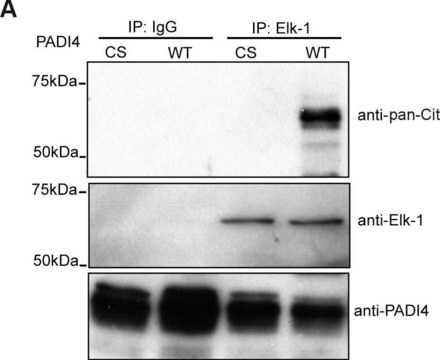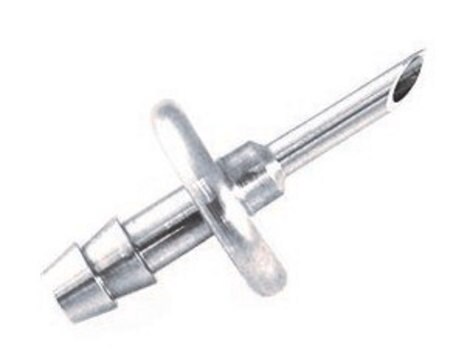MABF3220
Anti- HPV16 Antibody, clone H16.V5
Sinónimos:
HPV-16, Major capsid protein L1
About This Item
Productos recomendados
origen biológico
mouse
Nivel de calidad
forma del anticuerpo
purified antibody
tipo de anticuerpo
primary antibodies
clon
H16.V5, monoclonal
mol peso
calculated mol wt 56.3 kDa
observed mol wt ~N/A kDa
purificado por
using protein G
reactividad de especies
virus
envase
antibody small pack of 100
técnicas
ELISA: suitable
neutralization: suitable
isotipo
IgG2bκ
Nº de acceso Protein ID
Nº de acceso UniProt
temp. de almacenamiento
-10 to -25°C
Información sobre el gen
vaccinia virus ... L1(1489082)
Especificidad
Inmunógeno
Aplicación
Isotype testing: Identity Confirmation by Isotyping Test.
Isotyping Analysis: The identity of this monoclonal antibody is confirmed by isotyping test to be mouse IgG2b .
Tested Applications
ELISA Analysis: A representative lot of this antibody detected HPV16 protein in ELISA application (Data by Dr. J. Leitsch and with kind permission of ARTES Biotechnology GmbH, Germany. Recombinant HPV L1 antigens used were produced by ARTES Biotechnology GmbH).
Neutralizing: A representative lot detected HPV16 in Neutralizing application (Christensen, N.D., et al. (1996). Virology. 223(1):174-84; McClements, W.L., et al. (Virology). 289(2):262-8; Dias, D., et al. (2005). Clin Diagn Lab Immunol. 12(8):959-69; Smith, J.F., et al. (2008). Hum Vaccin. 4(2):134-42; Jerajani, K., et al. (2022). J Pharm Sci. 111(11):2983-2997).
ELISA Analysis: A representative lot detected HPV16 in ELISA application (Christensen, N.D., et al. (1996). Virology. 223(1):174-84; McClements, W.L., et al. (Virology). 289(2):262-8; Smith, J.F., et al. (2008). Hum Vaccin. 4(2):134-42; Panicker, G., et al. (2021). J Immunol Methods. 498:113136; Jerajani, K., et al. (2022). J Pharm Sci. 111(11):2983-2997).
Note: Actual optimal working dilutions must be determined by end user as specimens, and experimental conditions may vary with the end user.
Descripción de destino
Forma física
Reconstitución
Almacenamiento y estabilidad
Otras notas
Cláusula de descargo de responsabilidad
¿No encuentra el producto adecuado?
Pruebe nuestro Herramienta de selección de productos.
Código de clase de almacenamiento
12 - Non Combustible Liquids
Clase de riesgo para el agua (WGK)
WGK 2
Punto de inflamabilidad (°F)
Not applicable
Punto de inflamabilidad (°C)
Not applicable
Certificados de análisis (COA)
Busque Certificados de análisis (COA) introduciendo el número de lote del producto. Los números de lote se encuentran en la etiqueta del producto después de las palabras «Lot» o «Batch»
¿Ya tiene este producto?
Encuentre la documentación para los productos que ha comprado recientemente en la Biblioteca de documentos.
Nuestro equipo de científicos tiene experiencia en todas las áreas de investigación: Ciencias de la vida, Ciencia de los materiales, Síntesis química, Cromatografía, Analítica y muchas otras.
Póngase en contacto con el Servicio técnico



